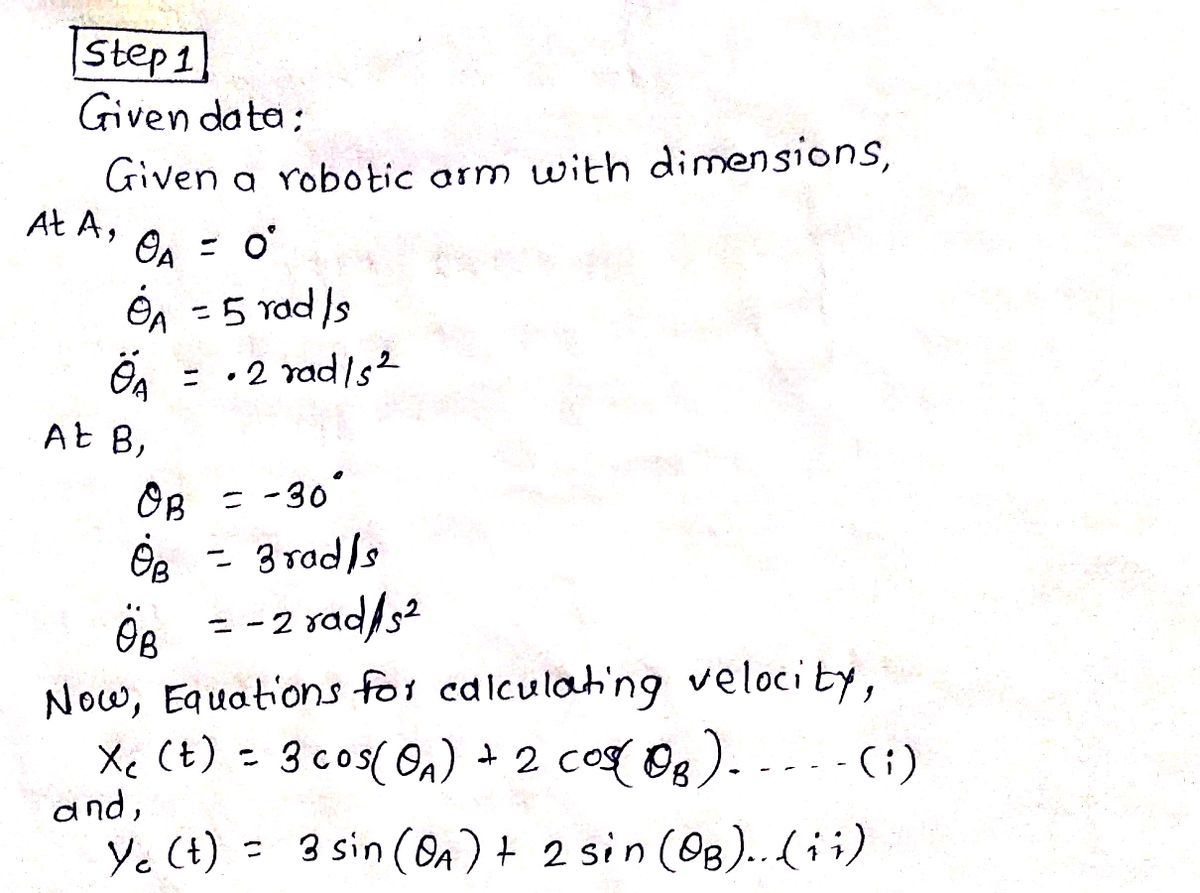● A ● 5 rad/s .2 rad/s² 3 ft x 3 rad/s -2 rad/s² B 2 ft • The robotic arm shown above has a fixed orange base at A and fixed length members AB and BC. 30⁰ Motors at A and B allow for rotational motion at the joints. Based on the angular velocities and accelerations shown at each joint (described with respect to the fixed frame): O Determine the velocity at the end effector at C o Determine the acceleration at the end effector at C
● A ● 5 rad/s .2 rad/s² 3 ft x 3 rad/s -2 rad/s² B 2 ft • The robotic arm shown above has a fixed orange base at A and fixed length members AB and BC. 30⁰ Motors at A and B allow for rotational motion at the joints. Based on the angular velocities and accelerations shown at each joint (described with respect to the fixed frame): O Determine the velocity at the end effector at C o Determine the acceleration at the end effector at C
Elements Of Electromagnetics
7th Edition
ISBN:9780190698614
Author:Sadiku, Matthew N. O.
Publisher:Sadiku, Matthew N. O.
ChapterMA: Math Assessment
Section: Chapter Questions
Problem 1.1MA
Related questions
Question

Transcribed Image Text:**Robotic Arm Dynamics:**
The diagram illustrates a robotic arm with a fixed orange base at point A and two arm segments: AB and BC. The arm is positioned in a 2D plane with a coordinate system labeled x and y.
### Diagram Explanation:
- **Arm Segments:**
- Segment AB is 3 feet long.
- Segment BC is 2 feet long and tilted at a 30° angle from the horizontal.
- **Joint Rotations:**
- Joint at A:
- Angular velocity: 5 rad/s
- Angular acceleration: 0.2 rad/s²
- Joint at B:
- Angular velocity: 3 rad/s
- Angular acceleration: -2 rad/s²
### Problem Statement:
The task is to calculate the kinematic parameters at the end effector located at point C. Specifically, you are required to:
- Determine the velocity at the end effector at C.
- Determine the acceleration at the end effector at C.
This analysis involves understanding rotational motion dynamics and applying them to calculate linear velocities and accelerations based on given angular velocities and accelerations.
Expert Solution
Step 1

Step by step
Solved in 4 steps with 4 images

Knowledge Booster
Learn more about
Need a deep-dive on the concept behind this application? Look no further. Learn more about this topic, mechanical-engineering and related others by exploring similar questions and additional content below.Recommended textbooks for you

Elements Of Electromagnetics
Mechanical Engineering
ISBN:
9780190698614
Author:
Sadiku, Matthew N. O.
Publisher:
Oxford University Press

Mechanics of Materials (10th Edition)
Mechanical Engineering
ISBN:
9780134319650
Author:
Russell C. Hibbeler
Publisher:
PEARSON

Thermodynamics: An Engineering Approach
Mechanical Engineering
ISBN:
9781259822674
Author:
Yunus A. Cengel Dr., Michael A. Boles
Publisher:
McGraw-Hill Education

Elements Of Electromagnetics
Mechanical Engineering
ISBN:
9780190698614
Author:
Sadiku, Matthew N. O.
Publisher:
Oxford University Press

Mechanics of Materials (10th Edition)
Mechanical Engineering
ISBN:
9780134319650
Author:
Russell C. Hibbeler
Publisher:
PEARSON

Thermodynamics: An Engineering Approach
Mechanical Engineering
ISBN:
9781259822674
Author:
Yunus A. Cengel Dr., Michael A. Boles
Publisher:
McGraw-Hill Education

Control Systems Engineering
Mechanical Engineering
ISBN:
9781118170519
Author:
Norman S. Nise
Publisher:
WILEY

Mechanics of Materials (MindTap Course List)
Mechanical Engineering
ISBN:
9781337093347
Author:
Barry J. Goodno, James M. Gere
Publisher:
Cengage Learning

Engineering Mechanics: Statics
Mechanical Engineering
ISBN:
9781118807330
Author:
James L. Meriam, L. G. Kraige, J. N. Bolton
Publisher:
WILEY